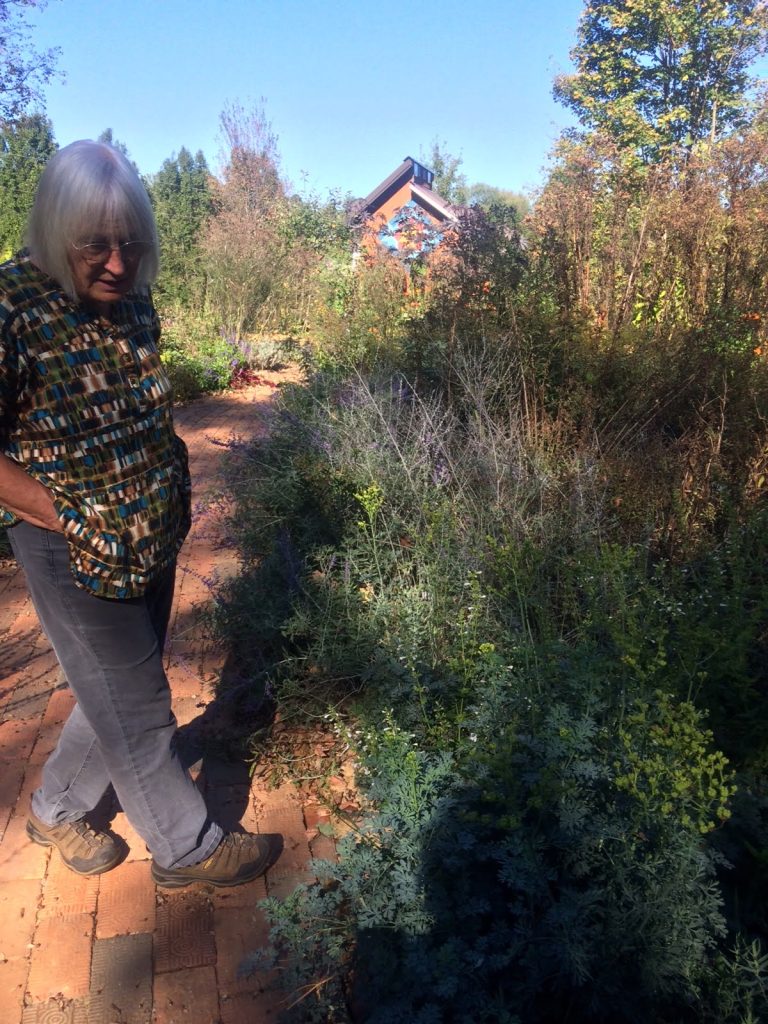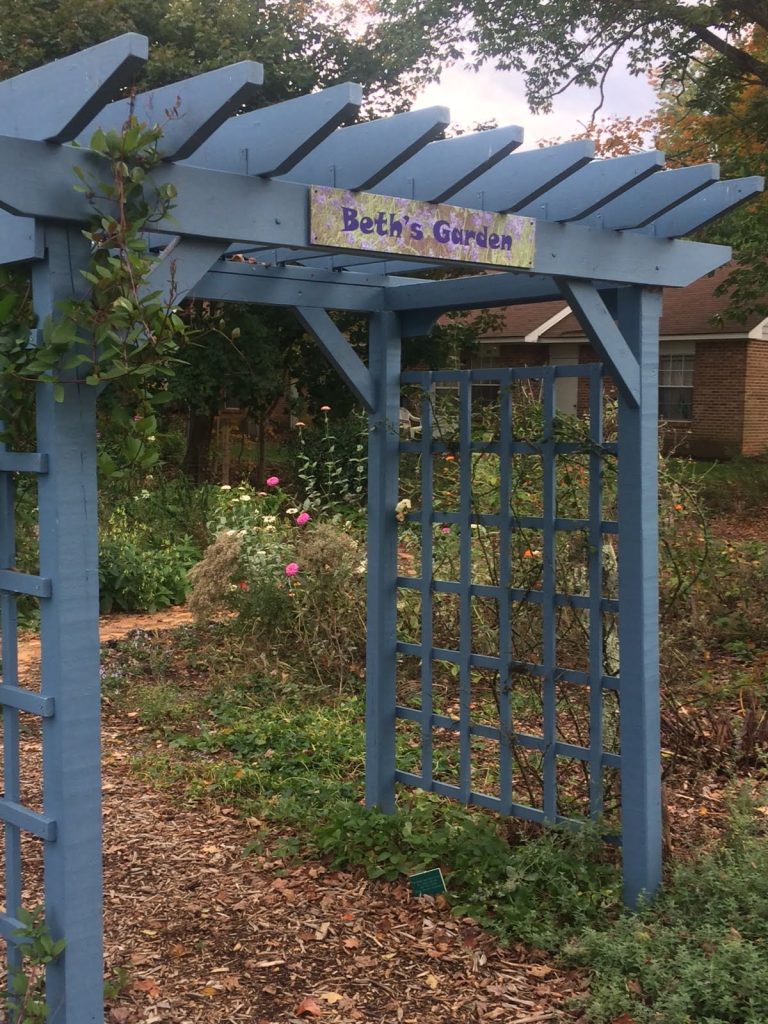Liz Kirchner
communitynews@ourvalley.org
Amid late-blooming roses on the pergola’d entrance to the Montgomery Museum’s garden, a pretty blue and green sign now says, in playful font, ‘Beth’s Garden.

Welcoming the community, a brick path winds among beds full of color and life at the Montgomery Museum thanks to Master Gardener, Beth Umberger.
That new sign thanks Master Gardener, Beth Umberger, who has been managing the upper and lower gardens at the Montgomery Museum for years, promoting gardens as places of play and learning, cultivating public awareness of native flora and fauna, and encouraging a general garden reveling.
She’d designed the garden to peak in late summer coinciding with Heritage Day at the museum, the third Saturday in August, but in a tour of the garden, on a blue and yellow October afternoon, Beth talks about the garden’s larger role in environmental education.
Through the gate, the brick path winds among beds full of color and life everything bouncing with bumblebees even in mid-October, and smells like hot wood mulch, maple leaves, and baked brick. It’s not a demure garden, the castor and iron weed are eight-feet tall standing theatrically as dark wine foils for orange zinnias and sunflowers.
But it’s not just good bones, it’s a smart, even scholarly garden.
“The main purpose is to show the community that it is possible to support our native flora and fauna without using plants that harm our native habitats,” Umberger said.
And through consistent, researched-backed education in gardens like this one, public awareness has shifted the way we garden.
“I’m starting to get more and more natives. Because there’s demand for natives, the nurseries are coming up with more and more cultivars that are good for gardens,” she said.
But there’s a debate, she said, about whether gardeners should plant pure species in our gardens or cultivars. Wild plants are pure species, usually, and people choose plants that come from those species, choosing characteristics they like. “They choose plants that are disease resistant, bloom longer, or don’t get tall and flop over and lie on the ground. And that’s what husbandry is. You choose what you like. And humans have always done that,” Umberger said.
But while you’re choosing for pretty blooms, are you choosing against something you don’t know about? Maybe flopping is somehow good for the plant or an insect that depends on it.

Quietly matter-of-fact and without fanfare, a pretty sign was hung on the blue pergola at the Montgomery Museum last week dedicating the garden to its quietly matter-of-fact gardener, Beth Umberger.
“This one I collected near Belview Elementary. It flops. So, if you plant something next to it, it’ll flop over on it. So most gardeners, and even me, I’m probably going to phase that out of here,” Umberger said, pointing to an tumble of aster. “I find weedy patches fascinating and full of things to explore, but a garden without beauty does not appeal to most people.” And this garden seems built to be explored.
Its sinuous path is Chilhowie brick (the town saved it for years for the museum, volunteers laid it recently) curves out of sight, pulling a visitor down the path to a shed and its handsome barn quilt in blues and umbers.
It’s a gardens-as-ecosystems lesson in the mounds of ornamental basils and salvia flowering in white trumpets and purple spires, are wiggling with bees and beetles, and the design is playful and effusive.
American painted lady butterflies bob on caution-cone orange Tithonia Mexican sunflowers. The path is lined with edibles. She’s flanked the path entrance with lemon tomato sentries ornamental basils in limes and purple are still flowering and a green chili mailed all the way from the Chili Institute in New Mexico.
Wending down the graceful path, Umberger points out the ironweed, a perennial native backdrop blossoming inky purple in late summer.
“I collected the seed for that behind Belview Elementary. That was my original goal. To only collect seed for this garden, and all, but I realized that I didn’t have that long in my life,” she said laughing.
Like all gardens, the Montgomery Museum garden is an ecosystem of people too. Beth is careful to first to say the garden is a group project and the list is a litany: two or three community service workers a year, a school group, church groups, service sororities, Ignite students, scout groups, local businesses, museum board members, Master Gardeners and their husbands, her own husband, Fred, who is also a Master Gardener.
“This is a Master Gardening project made possible by many volunteers from the community and the Montgomery Museum board. It is a community garden made possible by volunteers,” she said.
Beginning as bulldozed construction rubble 25 years ago, the hilltop oasis overlooks Roanoke Street. An oasis for the community too, families from the neighborhoods and nearby offices stroll at lunchtime, and children explore the garden and picnic on the hillside.
“We are thrilled to have Beth as Manager of our garden! She has brought it from a bed of weeds to an important place of beauty and learning for the entire community,” Sue Farrar, executive director of the Montgomery Museum and Lewis Miller Regional Art Center, said.
“As the County’s museum we feel privileged to have such a lovely spot to offer for picnics, weddings, or just strolling,” she said.
In addition to cultivating the museum garden and carrying out the education mission of the Master Gardeners, she is also a Master Naturalist. Wearing that hat, she battles invasive species in Blacksburg’s 300-year-old Stadium Woods and manages a rock garden in a street medium at College and Depot in Christiansburg. A garden is never complete, and, lucky for us, Umberger seems to find gardens everywhere.
For more information, contact the Montgomery Museum at (300 S. Pepper St. Christiansburg) (540) 382-5644, or visit www.montgomerymuseum.org.

